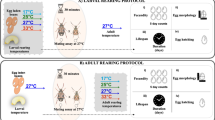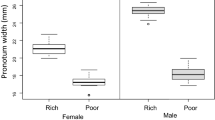Abstract
Sexual size dimorphism is widespread in animals but varies considerably among species and among populations within species. Much of this variation is assumed to be due to variance in selection on males versus females. However, environmental variables could affect the development of females and males differently, generating variation in dimorphism. Here we use a factorial experimental design to simultaneously examine the effects of rearing host and temperature on sexual dimorphism of the seed beetle, Callosobruchus maculatus. We found that the sexes differed in phenotypic plasticity of body size in response to rearing temperature but not rearing host, creating substantial temperature-induced variation in sexual dimorphism; females were larger than males at all temperatures, but the degree of this dimorphism was smallest at the lowest temperature. This change in dimorphism was due to a gender difference in the effect of temperature on growth rate and not due to sexual differences in plasticity of development time. Furthermore, the sex ratio (proportion males) decreased with decreasing temperature and became female-biased at the lowest temperature. This suggests that the temperature-induced change in dimorphism is potentially due to a change in non-random larval mortality of males versus females. This most important implication of this study is that rearing temperature can generate considerable intraspecific variation in the degree of sexual size dimorphism, though most studies assume that dimorphism varies little within species. Future studies should focus on whether sexual differences in phenotypic plasticity of body size are a consequence of adaptive canalization of one sex against environmental variation in temperature or whether they simply reflect a consequence of non-adaptive developmental differences between males and females.




Similar content being viewed by others
References
Anderson M (1994) Sexual selection. Princeton University Press, Princeton, N.J.
Angilletta MJ, Dunham AE (2003) The temperature-size rule in ectotherms: simple evolutionary explanations may not be general. Am Nat 162:332–342
Arnqvist G, Nilsson T, Katvala M (2005) Mating rate and fitness in female bean weevils. Behav Ecol 16:123–127
Atkinson D (1994) Temperature and organism size—a biological law for ectotherms? Adv Ecol Res 25:1–58
Badyaev AV (2002) Growing apart: an ontogenetic perspective on the evolution of sexual size dimorphism. Trends Ecol Evol 17:369–378
Berrigan D, Charnov EL (1994) Reaction norms for age and size at maturity in response to temperature: a puzzle for life historians. Oikos 70:474–478
Bieri J, Kawecki TJ (2003) Genetic architecture of differences between populations of cowpea weevil (Callosobruchus maculatus) evolved in the same environment. Evolution 57:274–287
Bisht IS, Bhat KV, Lakhanpaul S, Latha M, Jayan PK, Biswas BK, Singh AK (2005) Diversity and genetic resources of wild Vigna species in India. Genet Resour Crop Evol 52:53–68
Blanckenhorn WU (1997) Altitudinal life history variation in the dung flies Scathophaga stercoraria and Sepsis cynipsea. Oecologia 109:342–352
Blanckenhorn WU, Stillwell RC, Young KA, Fox CW, Ashton KG (2006) When Rensch meets Bergmann: does sexual size dimorphism change systematically with latitude? Evolution 60:2004–2011
Blanckenhorn WU, Dixon AFG, Fairbairn DJ, Foellmer MW, Gibert P, Van Der Linde K, Meier R, Nylin S, Pitnick S, Schoff C, Signorelli M, Teder T, Wiklund C (2007) Proximate causes of Rensch’s rule: does sexual size dimorphism in arthropods result from sex differences in development time? Am Nat 169:245–257
Chandrakantha J, Mathavan S (1986) Changes in developmental rates and biomass energy in Callosobruchus maculatus (F.) (Coleoptera: Bruchidae) reared on different foods and temperatures. J Stored Prod Res 22:71–75
Chandrakantha J, Muthukrishnan J, Mathavan S (1987) Effect of temperature and host seed species on the fecundity of Callosobruchus maculatus (F.). Proc Ind Acad Sci-Anim Sci 96:221–227
Credland PF, Dick KM, Wright AW (1986) Relationships between larval density, adult size and egg production in the cowpea seed beetle, Callosobruchus maculatus. Ecol Entomol 11:41–50
Dobson FS, Wigginton JD (1996) Environmental influences on the sexual dimorphism in body size of western bobcats. Oecologia 108:610–616
Fairbairn DJ (1997) Allometry for sexual size dimorphism: pattern and process in the coevolution of body size in males and females. Annu Rev Ecol Syst 28:659–687
Fairbairn DJ (2005) Allometry for sexual size dimorphism: testing two hypotheses for Rensch’s rule in the water strider Aquarius remigis. Am Nat 166:S69–S84
Fischer K, Fiedler K (2000) Sex-related differences in reaction norms in the butterfly Lycaena tityrus (Lepidoptera: Lycaenidae). Oikos 90:372–380
Fischer K, Fiedler K (2001) Dimorphic growth patterns and sex-specific reaction norms in the butterfly Lycaena hippothoe sumadiensis. J Evol Biol 14:210–218
Fox CW, Bush ML, Roff DA, Wallin WG (2004a) Evolutionary genetics of lifespan and mortality rates in two populations of the seed beetle, Callosobruchus maculatus. Heredity 92:170–181
Fox CW, Czesak ME, Wallin WG (2004b) Complex genetic architecture of population differences in adult lifespan of a beetle: nonadditive inheritance, gender differences, body size and a large maternal effect. J Evol Biol 17:1007–1017
Fox CW, Stillwell RC, Amarillo AR, Czesak ME, Messina FJ (2004c) Genetic architecture of population differences in oviposition behaviour of the seed beetle Callosobruchus maculatus. J Evol Biol 17:1141–1151
Fox CW, Czesak ME (2006) Selection on body size and sexual size dimorphism differs between host species in a seed-feeding beetle. J Evol Biol 19:1167–1174
Fox CW, Stillwell RC, Moya-Laraño J (2007) Variation in selection and the evolution of sexual size dimorphism in two seed-feeding beetles. In: Fairbairn DJ, Blanckenhorn WU, Székely T (eds) Sex, size and gender roles: evolutionary studies of sexual size dimorphism. Oxford University Press, Oxford (in press)
Guntrip J, Sibly RM, Holloway GJ (1997) The effect of novel environment and sex on the additive genetic variation and covariation in and between emergence body weight and development period in the cowpea weevil, Callosobruchus maculatus (Coleoptera: Bruchidae). Heredity 78:158–165
Lovich JE, Gibbons JW (1992) A review of techniques quantifying sexual size dimorphism. Growth Dev Aging 56:269–281
Mackauer M (1996) Sexual size dimorphism in solitary parasitoid wasps: influence of host quality. Oikos 76:265–272
Mbata GN, Johnson M, Phillips TW, Payton M (2005) Mortality of life stages of cowpea weevil (Coleoptera: Bruchidae) exposed to low pressure at different temperatures. J Econ Entomol 98:1070–1075
Messina FJ (1991) Life-history variation in a seed beetle: adult egg-laying vs. larval competitive ability. Oecologia 85:447–455
Messina FJ (1993) Heritability and evolvability of fitness components in Callosobruchus maculatus. Heredity 71:623–629
Messina FJ, Karren ME (2003) Adaptation to a novel host modifies host discrimination by the seed beetle Callosobruchus maculatus. Anim Behav 65:501–507
Messina FJ (2004a) Predictable modification of body size and competitive ability following a host shift by a seed beetle. Evolution 58:2788–2797
Messina FJ (2004b) How labile are the egg-laying preferences of seed beetles? Ecol Entomol 29:318–326
Mitchell R (1991) The traits of a biotype of Callosobruchus maculatus (F.) (Coleoptera: Bruchidae) from South India. J Stored Prod Res 27:221–224
Morin JP, Moreteau B, Petavy G, David JR (1999) Divergence of reaction norms of size characters between tropical and temperate populations of Drosophila melanogaster and D. simulans. J Evol Biol 12:329–339
Nylin S, Gotthard K (1998) Plasticity in life history traits. Annu Rev Entomol 43:63–83
Savalli UM, Fox CW (1999) The effect of male size, age, and mating behavior on sexual selection in the seed beetle Callosobruchus maculatus. Ethol Ecol Evol 11:49–60
Savalli UM, Czesak ME, Fox CW (2000) Paternal investment in the seed beetle Callosobruchus maculatus (Coleoptera: Bruchidae): variation among populations. Ann Entomol Soc Am 93:1173–1178
Smith RJ (1999) Statistics of sexual size dimorphism. J Hum Evol 36:423–459
Stillwell RC, Fox CW (2005) Complex patterns of phenotypic plasticity: interactive effects of temperature during rearing and oviposition. Ecology 86:924–934
Stillwell RC, Wallin WG, Hitchcock LJ, Fox CW (2007) Phenotypic plasticity in a complex world: interactive effects of food and temperature on fitness components of a seed beetle. Oecologia (in press)
Teder T, Tammaru T (2005) Sexual size dimorphism within species increases with body size in insects. Oikos 108:321–334
Vamosi SM (2005) Interactive effects of larval host and competition on adult fitness: an experimental test with seed beetles (Coleoptera: Bruchidae). Funct Ecol 19:859–864
Van Huis A, de Rooy M (1998) The effect of leguminous plant species on Callosobruchus maculatus (Coleoptera: Bruchidae) and its egg parasitoid Uscana lariophaga (Hymenoptera: Trichogrammatidae). Bull Entomol Res 88:93–99
Acknowledgements
We thank L. Hitchcock, D. Johnson, O. Njoku and W. Wallin for help weighing beetles during the experiment. We thank F. Messina for providing the laboratory colonies and D. Westneat for statistical advice. We also thank M. Chappell, D. Fairbairn and one anonymous reviewer for helpful comments on the manuscript. Financial support was provided in part by a National Science Foundation grant (DEB-01-10754) to C. W. F. Institutional guidelines were followed for animal care.
Author information
Authors and Affiliations
Corresponding author
Additional information
Communicated by Mark Chappell.
Rights and permissions
About this article
Cite this article
Stillwell, R.C., Fox, C.W. Environmental effects on sexual size dimorphism of a seed-feeding beetle. Oecologia 153, 273–280 (2007). https://doi.org/10.1007/s00442-007-0724-0
Received:
Accepted:
Published:
Issue Date:
DOI: https://doi.org/10.1007/s00442-007-0724-0




